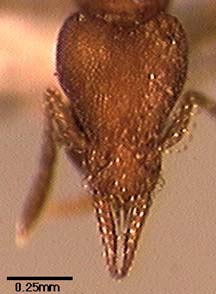Neostruma pasisops Bolton ms
This manuscript name is a conditional proposal by B. Bolton (sensu Article 15 of the 1985 ICZN), and thus not made available here. Its appearance here or in any duplication of this page does not constitute publication (sensu Article 8 of the 1985 ICZN).
Formicidae, Hymenoptera, Insecta, Arthropoda, Animalia

Specimen: Costa Rica, Prov. Puntarenas: Monteverde, EAP1991, INBIOCRI001283855. Image by J. Longino.
Identification
Total head length > 0.90mm; mandibles with approximately 7 preapical denticles, gradually increasing in size toward basal denticle; eyes very large, with approximately 20 facets; propodeal suture moderately impressed.
Range
Costa Rica (Monteverde).
Natural History
Brown (1959) characterizes the genus as a whole as forming |

Specimen: Costa Rica, Prov. Puntarenas: Monteverde, EAP1991, INBIOCRI001283855. Image by J. Longino. |
"small colonies, chiefly in the leaf litter of rain forest or tropical evergreen forest, and nests occupy cavities in rotting twigs, pieces of bark or similar forest-floor vegetable debris... The food... consists primarily of small entomobryomorph Collembola and possibly some other minute terrestrial arthropods as well. Hunting behavior is like that of Smithistruma rather than like the Strumigenys so far studied."
Selected Records
Known from two workers (two separate collections: P. S. Ward #3530, and one collected as part of a class project taught by J. T. Longino) from Monteverde cloud forest.
Literature Cited
Brown, W. L., Jr. 1959. A revision of the Dacetine ant genus Neostruma. Breviora 107:1-13.
John T. Longino, The Evergreen State College, Olympia WA 98505
USA.
longinoj@evergreen.edu
Last modified: 10 June 1997

